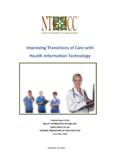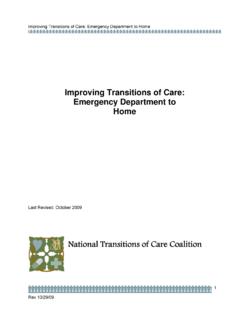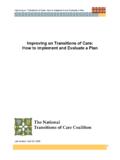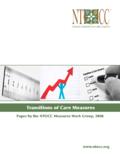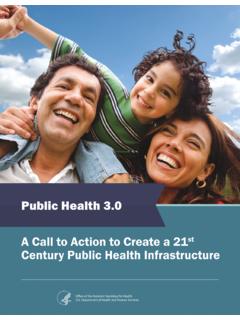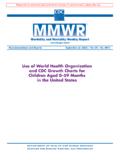Transcription of Improving Transitions of Care - ntocc.org
1 SEPTEMBER 2010 Improving Transitions of Care Findings and Considerations of the Vision of the National Transitions of Care Coalition In the United States health and long-term care system, patients particularly the elderly and individuals with chronic illnesses experience Transitions in their care, meaning that they leave one care setting ( hospital, nursing facility, assisted living facility, primary care physician care, home health care, or specialist care), and move to another.
2 Care coordination is a related, but distinct concept, which refers to the interaction of providers to ensure optimal care for a patient. Every transition of care will involve care coordination, but care coordination is a broader process that typically encompasses the assessment of the patient s needs, development and implementation of a plan of care, and evaluation of the care plan. Some facts about Transitions of care that policymakers should know: Among hospitalized patients 65 or older, 21 percent are discharged to a long term care or other Approximately 25 percent of Medicare skilled nursing facility (SNF)
3 Residents are readmitted to the Individuals with chronic conditions a number expected to reach 125 million in the by 2020 may see up to 16 physicians in one Between and 70 percent of Medicare patients admitted to the hospital for care in 2003 received services from an average of 10 or more physicians during their Health and Economic Costs of Poor Transitions of Care The health care system often fails to meet the needs of patients during Transitions because care is rushed and responsibility is fragmented, with little communication across care settings and multiple providers.
4 A recent survey by the Agency for Healthcare Research and Quality (AHRQ) on Patient Safety Culture, found that 42% of the hospitals surveyed reported that things fall between the cracks when transferring patients from one unit to another and problems often occur in the exchange of information across hospital units. v Poor communication during Transitions from one care setting to another can lead to confusion about the patient s condition and appropriate care, duplicative tests, inconsistent patient monitoring, medication errors, delays in diagnosis and lack of follow through on referrals.
5 These failures create serious patient safety, quality of care, and health outcome concerns. Furthermore, they place significant financial burdens on patients and the health care system as a whole. All of these variables contribute to patient and family caregivers dissatisfaction with the health care system. We need only to look at the high prevalence of hospital readmissions and medical errors to see the inadequacies of care Transitions and their adverse economic implications to the health care system: Medication errors harm an estimated million people each year in the United States, costing the nation at least $ billion One study found that, on discharge from the hospital, 30% of patients have at least one medication According to another study, one in five patients discharged to their home from the hospital experienced an adverse event within three weeks of discharge.
6 Sixty percent were medication related and could have been On average, of Medicare fee-for-service beneficiaries who have been discharged from the hospital were readmitted within 30 days and 34% were readmitted within 90 According to MEDPAC, hospital readmissions within 30 days accounted for $15 billion of Medicare Consensus on the Need to Reform Health care experts have long identified the lack of connectivity and fragmentation in our health care system as barriers to the delivery of high quality and efficient health care. In 2001, the Institute of Medicine issued a report that called for increased care coordination across the health care system to improve quality of care and reduce The Commonwealth Fund also urged improved care coordination as a primary strategy to reduce inefficiencies in the health care In 2008, the National Priority Partnership identified care coordination as one of six national priorities, noting that increased communication between patients and providers, stronger record keeping, and more efficient.
7 Patient-centered care can reduce harm while making healthcare more reliable and accessible. xiii In 2010, enactment of the Patient Protection and Accountability Care Act (PPACA) put in place new programs aimed at Improving the quality of the health care delivery system. In recognition of the value of proper Transitions in leading to improved care and the social and economic costs of poor Transitions , PPACA included several initiatives specifically designed to address gaps in care that occur between and among health care settings. Improving Transitions of Care The National Transitions of Care Coalition (NTOCC) and its multidisciplinary team of health care leaders are committed to Improving the quality of Transitions of care.
8 NTOCC s mission is to raise awareness about the importance of Transitions in Improving health care quality, reducing medication errors and enhancing clinical outcomes among health care professionals, government leaders, patients, and family caregivers. NTOCC has also developed a number of tools and resources for professionals, patients, and family caregivers to ensure safe Transitions of care. As new policies, programs, and practices emerge that seek to improve care Transitions , the experts at NTOCC believe the following considerations should be taken into account to achieve successful Transitions of care: Improve communication during Transitions between providers, patients and family caregivers; Implement electronic health records that include standardized medication reconciliation elements; Expand the role of pharmacists in Transitions of care in respect to medication reconciliation.
9 Establish points of accountability for sending and receiving care, particularly for hospitalists, SNFists, primary care physicians and specialists; Increase the use of case management and professional care coordination; Implement payment systems that align incentives; and Develop performance measures to encourage better Transitions of care. NTOCC has pulled together resources from across a spectrum of leading health care experts and stakeholders and seeks to be a resource not only to patients, clinicians and family caregivers, but also to policymakers as work continues to improve health care quality through effective Transitions of care.
10 I Hospitalization in the United States, 2002, Agency for Healthcare Research and Quality, 2002 .< #howdischarged>. ii Medicare Payment Advisory Commission, Report to the Congress: Increasing the Value of Medicare, June 2006. iii Bodenheimer, T, Coordinationg Care-a perilous journey through the health system, New England Journal of Medicine, 2008; 358(10):1064-1071. iv Fisher, E, Performance, Measurement: Achieving Accountability for Quality and Costs, Quality Forum Annual Conference on Health Policy, October 2006.

